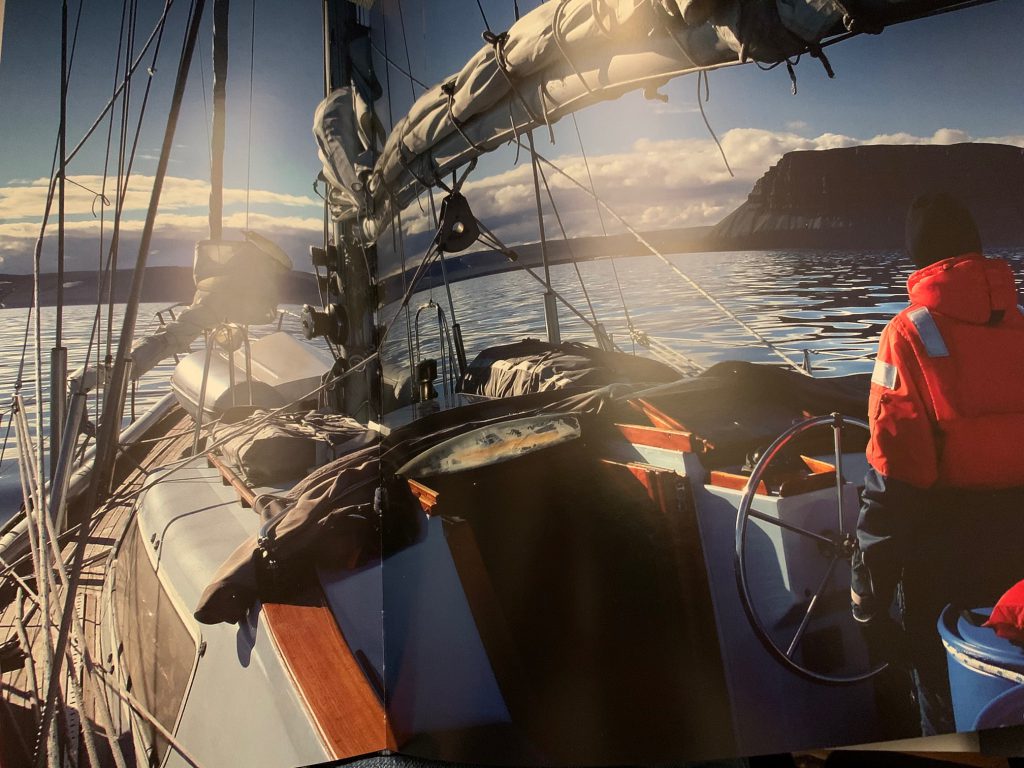This blog post has nothing to do with HVAC software, nor sustainable design software, nor, as a matter of fact, any type of software the Carmel develops. However, I felt the need to write this post since it deals with reducing greenhouse gas emissions, which is what our software is all about.
In fact, our software is all about helping engineers, architects, and technicians design more energy efficient buildings. Also, Carmel oversees the Green Building XML (gbXML) schema that allows disparate software tools in the building design space to communicate with one another, all in the name of designing more energy efficient buildings.
I truly hope our software is doing its part to help reduce our greenhouse gas emissions that are adversely affecting our planet in so many ways. I’ve lived in California for 20+ years, but only during the past 3 years have the wildfires consistently affected our way of life. I’ve always been wary of whether man truly affects our environment, but now that I am seeing it and experiencing it first-hand, I now believe it, hands-down. I have personally witnessed a marked and extreme effect of climate change: wildfires quite literally in my backyard and air so unbreathable that I need to wear N95 masks outside when on a run or bike ride. This has consistently happened over the past 3 late-summers/falls and prior to 2017, this NEVER happened. Something is seriously wrong.
Living in California, I am seeing more and more how man is altering our environment for the worse. Paradise, California has burned twice in the past two years. If that isn’t a message, I don’t know what else is.
That being said, I’ve decided to do my small part in reducing greenhouse gas emissions by biking to work 2 days/week. I am lucky enough to live within 10 miles of my office and also to live in a part of the country where the weather is fairly predictable during the spring and summer. Therefore, I am able to consistently bike to work each week.
Being a degreed professional mechanical engineer and software designer, I’d like to focus on the metrics of biking each day: how much I’m biking, calories I’m expending, gas I’m saving, and greenhouse gas emissions I’m reducing. However, before I delve into the metrics of biking, I’d like to talk about the more intangible benefits and features.
First of all, I truly love biking. There’s something about it that is so visceral for me. If I lived in the 1800s in the American Wild West, I probably would have loved riding horses. In fact, there are similarities between bicycling and riding horses: being thoroughly engulfed in nature, the wind, the natural means of speed beyond human capabilities. I often visualize my long bike rides during the week, anticipating them with increased urgency. In fact, I’ll admit, I’m a bit crazy when it comes to bicycling. I’ll get up at 4:30 am on Sunday mornings and bike 55 miles in 40 degree weather. I’m the only one on the road in West Marin County at that time. The comedian/actor Robin Williams (an avid biker who owned 50+ bikes) once said: “My favorite thing to do is ride a bicycle. I ride road bikes. And for me, it’s mobile meditation.” I can relate.
When it comes to biking to work, even after biking only 8 or so miles, I feel great. Yes, I am sweaty and need to change my shirt and apply deodorant, but I am energized and awake. Compare this to driving, I often have to fight to stay awake while drive just 8 miles to work. And when I do arrive to work, I am sometimes lethargic. I am NEVER lethargic when biking to work.
Another intangible benefit is that I’m super hungry and thirsty at the end of the day after biking just 16 miles to and from work. Food always tastes so much better on a hungry stomach.
Now, let’s talk metrics: I LOVE metrics and both the Garmin mobile app (I own a Garmin watch) and the Strava website provide tons of data and metrics.
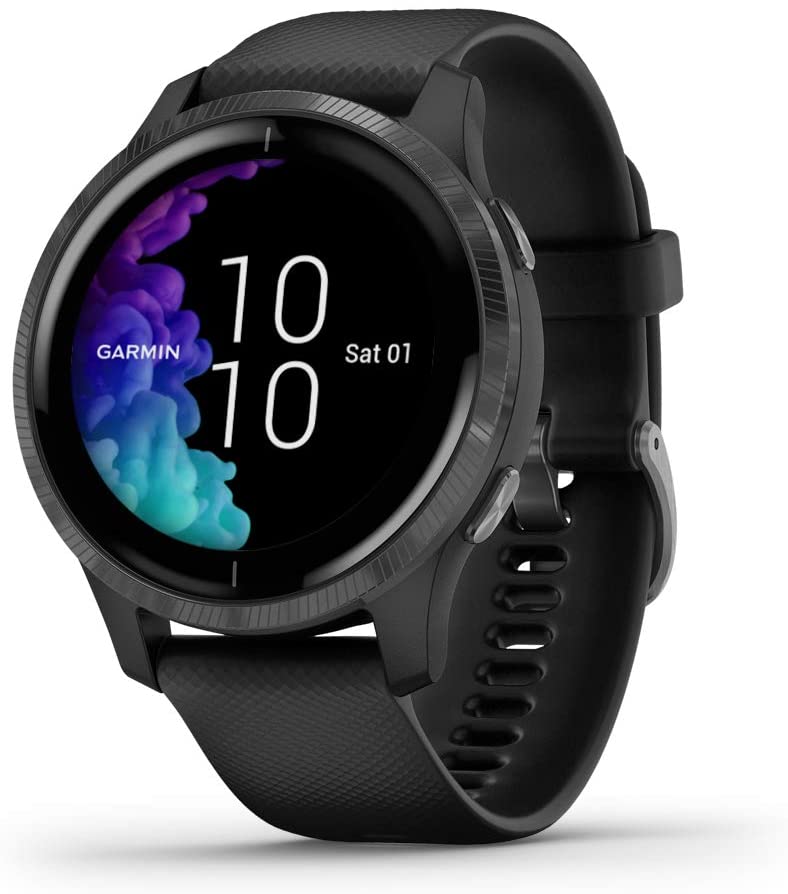
My average time to work from home is about 40 minutes (compared with 15 minutes by car). The timing varies by 5+ minutes depending upon if I catch traffic lights and light-rail intersections. Also, other variables such as outside air temperature and wind speed affect my time: the colder it is (and the higher the wind speed, obviously), the slower I bike (often by 5 to 10 minutes).
The exact instance to work is 7.68 miles. The elevation is 500 ft. My average speed is 12 mph. There are a number of traffic lights on the way to work (5 to be exact). Also, there is a light-rail crossing which often causes a 5 minute delay. The following is a screenshot of one of my rides to work:
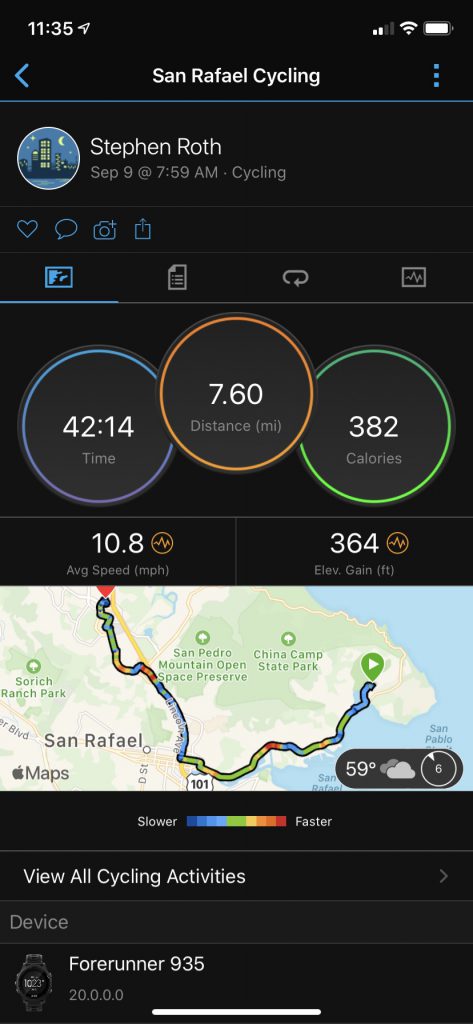
There’s a nice gradual elevation that runs parallel to Highway 101 (located in Marin County, CA, just north of San Francisco) that runs for about 1 mile or so. Following that elevation, the rest of the ride to work is either downhill or at an even elevation.
Calories burned are about 300 according to app. Realistically, I think calories burned are about 250 (I am 6’1″ and weigh around 155). Anecdotally, I’ve calculated that for each mile I bike, I burn around 35 calories (this is an average since some miles are downhill and others can be brutally uphill). Since I am also a runner, I calculated that every 3 miles of biking is equivalent to 1 mile of running in terms of calories burned (ie – 100 calories / mile of running).
Therefore, by bicycling to work, I am doing the following:
- Riding 35 miles/week to work versus driving. This saves around 1.5 gallons of gas per week or 75 gallons of gas per year. While this is equivalent to only around $300/yr savings (I spend more than that on bike maintenance, new tires, and new brakes/year), if just 1,000,000 people (0.3% of the US population) nationwide did this, then we are talking 75,000,000 gallons of savings per year.
- I’m reducing mileage on my car to the tune of 1,800 miles/year, which does translate into reduced wear and tear on my car and tires. This equates to an additional $500 in savings in terms of wear and tear. Also, due to COVID-19, car insurance companies are reducing premiums for less miles driven since so many people are working from home.
- In terms of carbon reduction, I’m reducing CO2 emissions by 0.61 metric tons/year.
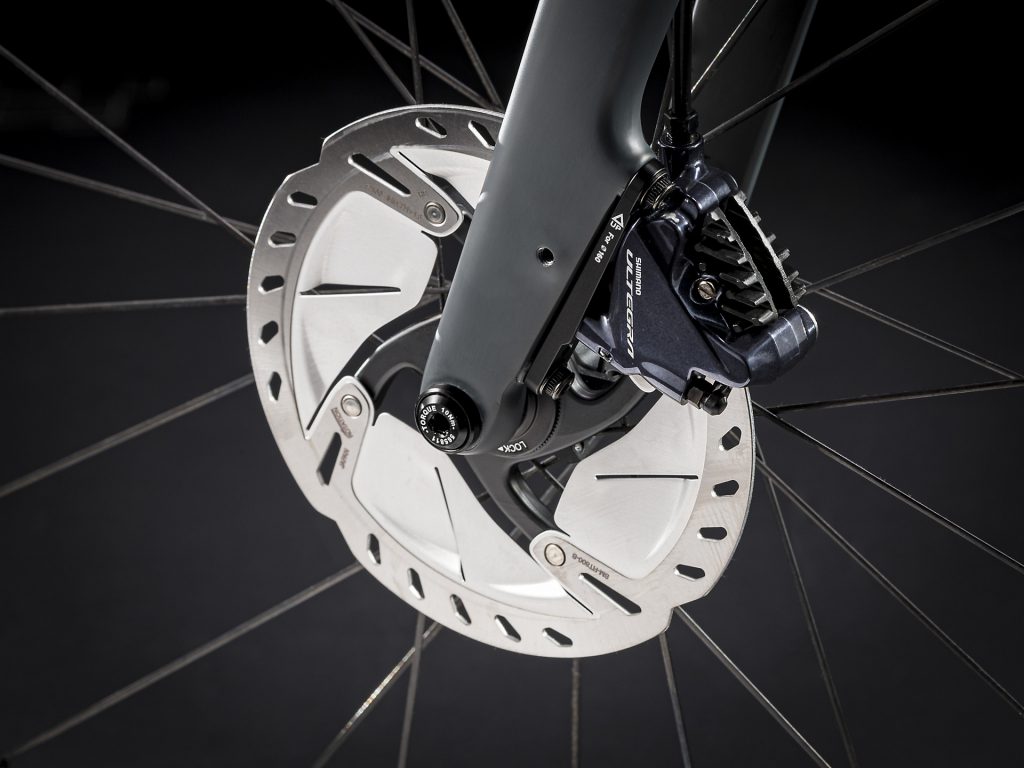
What about health benefits? I’m lucky to already be in good shape and at a good weight for my height. However, given the fact that over 30% of the US is obese, what if every American biked an average of 15 miles to and from work 2x per week, how much weight loss are we talking? As I mentioned above, the average calories burned are around 500 calories/ride back and forth. Since a pound of weight is equal to 3600 calories, it takes around around 7 back/forth rides to reduce 1 pound (assuming you do not eat more to offset the calories burned). Assuming you ride 2x/week, this translates into about 1 lb/month or 12 lbs/year. For someone who is 50 lbs overweight, this translates into a relatively easy way to lose that weight over a 4 year period (yes, I admit it’s not a fast way to lose the weight, but it’s a slow/consistent way to lose it and keep it off forever). Most weight-loss programs cannot claim this.
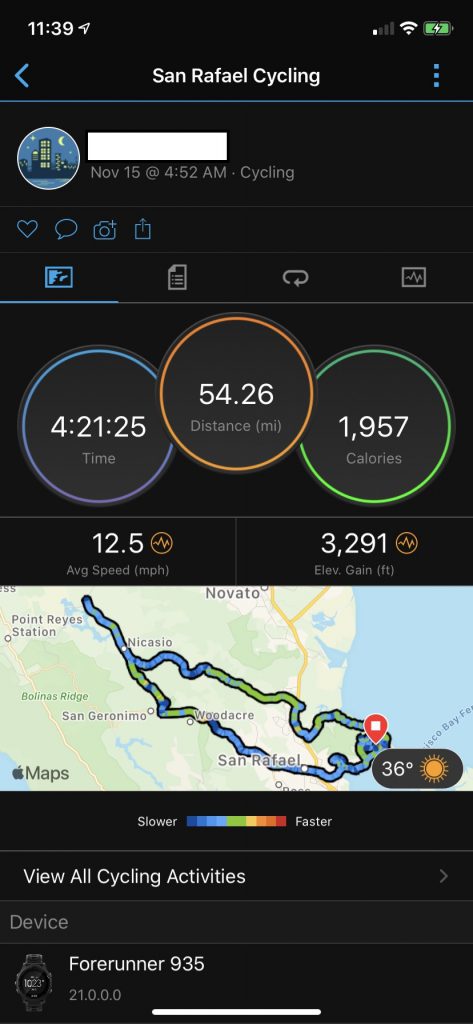
Other observations while riding a bike:
When in a car, it’s so easy to become disconnected from your surroundings and environment. You’re in a climate controlled environment with windows closed often listening to music or talk radio. However, when riding a bike, you are inherently immersed in the surrounding environment. It’s so much easier to observe the environment, both good and bad.
The bad:
Trash: I’m appalled by how much litter is on the sides of downtown roads and highways. It boggles my mind that people would throw trash outside their car instead of waiting to get home to place it in garbage bin.
Homelessness: While it’s hard to avoid seeing the homelessness while in a car; when on a bike, you feel the proximity even more so. Plus, you can hear their ramblings. It makes one realize how sad a situation homelessness is and how hopeless these people feel.
The good:
I feel I really get to know the town I live in by bicycling through it. It gives me a renewed appreciation for it and helps me feel more connected to it.
Parking is NEVER A problem. I can stop at the bank downtown without worrying about finding and paying for parking.
Most importantly, biking ALWAYS feels like an adventure to me. There’s constantly challenges and encounters that make it so engaging and interesting. Even picking up my wife’s prescriptions from the pharmacy feels like a fun adventure. Go figure.
To the contrary, driving does not feel like an adventure. In fact, it feels like a necessary burden. I always have a dreadful feeling driving due to bad traffic expectations, backups through downtown, lack of parking, etc. There’s NEVER a traffic backup when you are biking.
I recently bought a 2nd bike. My commute bike is on a 3-year old Trek FX 6 Sport hybrid, which has been great for commuting. My new bike is a Trek Domane TR 7 high-performance road-bike. What an engineering marvel: electronic shifting, incredible performance, hydraulic brakes, and so much more. Anecdotally, I compared my time over a 5 mile route on my hybrid vs. my new road-bike: a 6 minute improvement over my hybrid for every 5 miles. It really pays to have the right tools.

In summary, I wish I could convince more people to bike to work. It’s hard, I know, but Mother Earth is revolting against the excesses of 8 billion+ human beings: wildfires in CA and the Amazon, the most powerful hurricanes in recorded history, world-wide droughts, a Northwest Passage free of ice for the first time in human history. Look at the 2 pictures below. Need I say more?

